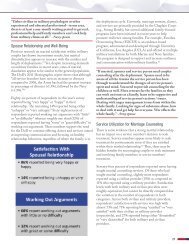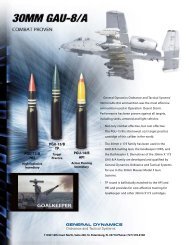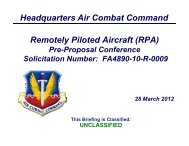F-35 Joint Strike Fighter (JSF) - WordPress.com
F-35 Joint Strike Fighter (JSF) - WordPress.com
F-35 Joint Strike Fighter (JSF) - WordPress.com
You also want an ePaper? Increase the reach of your titles
YUMPU automatically turns print PDFs into web optimized ePapers that Google loves.
DOD PROGRAMS<br />
observed as a function of flight time. Current program<br />
objectives for early mission system software in<br />
flight test are to have integrated core processor and<br />
Communications / Navigation / Identification Friend or Foe<br />
(CNI) anomaly rates be 15 hours or more between events.<br />
Recent reports for the latest mission systems software in<br />
flight test – version 2AS2.8 – show a rate of 6.3 hours<br />
between anomalies based on 88 hours of flight test.<br />
Weapons Integration<br />
• Weapons integration includes flight sciences, mission systems,<br />
and ground maintenance support. Testing includes measuring<br />
the environment around the weapon during carriage (internal<br />
and external), handling characteristics of the aircraft, safe<br />
separation of the weapon from the aircraft, and weapons<br />
delivery accuracy events.<br />
• In 2012, the program conducted detailed planning of the<br />
weapons integration events necessary to <strong>com</strong>plete SDD.<br />
This planning yielded a schedule for <strong>com</strong>pleting weapons<br />
integration for Block 2B and Block 3F <strong>com</strong>bat capability.<br />
• The test team conducted the flight sciences loads, flutter, and<br />
environmental testing necessary to certify a limited Block 2B<br />
carriage envelope of the F-<strong>35</strong>A and F-<strong>35</strong>B aircraft for <strong>Joint</strong><br />
Direct Attack Munition, GBU-12 laser guided bomb, and<br />
the AIM-120 air-to-air missile to enable the start of active<br />
flight testing. As of the end of October, this testing had<br />
achieved captive carriage and first safe separation of an inert<br />
AIM-120 missile (on the A model) and inert <strong>Joint</strong> Direct<br />
Attack Munition (on both the A and B model). However, to<br />
date, weapons integration has been limited by the following<br />
deficiencies:<br />
- Instrumentation<br />
- Data recording shortfalls<br />
- Deficient mission systems performance in radar,<br />
Electro‐Optical Targeting System (EOTS), fusion, and the<br />
helmet<br />
- Lack of radar fusion support to the AIM-120 air-to-air<br />
missile<br />
- EOTS inability to accurately track and designate targets for<br />
the air-to-ground munitions,<br />
- Deficient fused situational awareness presentation to the<br />
pilot<br />
• The successful execution of the detailed schedule developed<br />
this year was dependent on:<br />
- The ability of the program to deliver mission systems<br />
capability required to start weapons integration in<br />
April 2012<br />
- Adequate margin in the test schedule to ac<strong>com</strong>modate<br />
repeated testing, cancellations due to weather, range assets,<br />
and operational support<br />
- Reliable instrumentation and range support<br />
• None of these assumptions have proven true, adding risk to<br />
the execution of the overall schedule. Deferrals of mission<br />
systems capabilities to later blocks and delays for corrections<br />
to test instrumentation and data recording have removed the<br />
schedule margins. The impact of these delays will potentially<br />
require an additional 18 months added to the schedule for<br />
weapons integration events.<br />
Static Structural and Durability Testing<br />
• Durability testing on the ground test articles of all three<br />
variants continued in 2012; progress is measured in aircraft<br />
lifetimes. An aircraft lifetime is defined as 8,000 Equivalent<br />
Flight Hours (EFH), which is a <strong>com</strong>posite of time under<br />
different test conditions (i.e., maneuver and buffet for<br />
durability testing). In accordance with the SDD contract, all<br />
three variants will <strong>com</strong>plete two full lifetimes, or 16,000 EFH<br />
of durability testing. The <strong>com</strong>pletion dates for the second<br />
aircraft lifetimes are late 2014 for the F-<strong>35</strong>B and early 2015<br />
for the F-<strong>35</strong>A and F-<strong>35</strong>C. Plans for a third lifetime of<br />
durability testing for all three variants are under development.<br />
• The F-<strong>35</strong>A ground test article, AJ-1, <strong>com</strong>pleted the first of<br />
two planned aircraft lifetimes in August, as planned. F-<strong>35</strong>A<br />
durability testing continued into the second planned aircraft<br />
lifetime at the time of this report, <strong>com</strong>pleting 9,117 EFH as of<br />
December 5, 2012.<br />
• F-<strong>35</strong>B durability testing on BH-1 was restarted in January after<br />
a 16-month break caused by the discovery, analysis, and repair<br />
of a crack in a wing carry-through bulkhead at 1,055 EFH.<br />
Since restarting, an additional 5,945 hours of testing had been<br />
<strong>com</strong>pleted by the end of October, bringing the total test time<br />
to 7,000 EFH and putting the testing ahead of the restructured<br />
2012 plan to <strong>com</strong>plete 6,500 hours by the end of the year.<br />
• F-<strong>35</strong>C durability testing began in March and the test article,<br />
CJ-1, had <strong>com</strong>pleted 4,000 EFH of fatigue testing as of<br />
October, as scheduled.<br />
• Component durability testing for two lifetimes of the vertical<br />
tails was <strong>com</strong>pleted for the F-<strong>35</strong>A and F-<strong>35</strong>B during 2012.<br />
This testing was started in August for the F-<strong>35</strong>C. Component<br />
testing of the horizontal tail for the F-<strong>35</strong>C <strong>com</strong>pleted<br />
8,000 EFH, or one lifetime, in May, and an additional<br />
2,000 EFH by the end of October. (Component testing of<br />
the horizontal tails for the F-<strong>35</strong>A and F-<strong>35</strong>B <strong>com</strong>pleted two<br />
lifetimes of testing in 2011.)<br />
• The program redesigned the F-<strong>35</strong>B auxiliary air inlet doors,<br />
required for STOVL operations, and began flight testing in<br />
2012. Redesigned doors have been installed on the static loads<br />
test article (BG-1) and <strong>com</strong>pleted static loads testing in early<br />
November, followed by the start of durability testing. The<br />
report from the static testing is scheduled to be <strong>com</strong>pleted by<br />
the end of 2012; however, the results of the durability testing<br />
are not scheduled to be available until mid-2013. The program<br />
has already ordered, received, and begun installing retrofit kits<br />
for the auxiliary air inlet door modifications on fielded Lot 4<br />
aircraft.<br />
• Discoveries from durability testing included significant<br />
findings in both the F-<strong>35</strong>A and F-<strong>35</strong>B ground test articles.<br />
- In the F-<strong>35</strong>A, a crack was discovered on the right wing<br />
forward root rib at the lower flange (this is in addition to<br />
the crack found and reported in the FY11 Annual Report).<br />
36 F-<strong>35</strong> <strong>JSF</strong>






